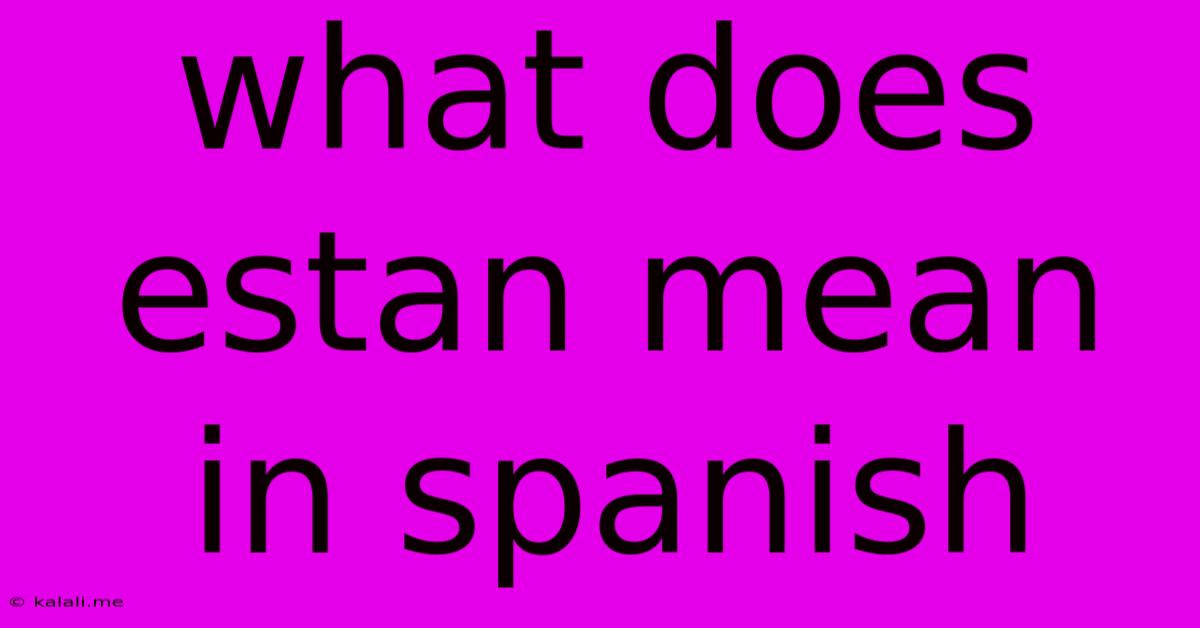What Does Estan Mean In Spanish
Kalali
May 31, 2025 · 2 min read

Table of Contents
What Does "Están" Mean in Spanish? A Comprehensive Guide
Understanding the nuances of the Spanish language can be challenging, especially when dealing with verb conjugations. One such word that often trips up learners is "están." This article will provide a comprehensive explanation of what "están" means, its various uses, and how to use it correctly in different contexts. This guide will cover everything you need to know about this common Spanish verb conjugation, helping you confidently incorporate it into your conversations and writing.
Understanding the Verb "Estar"
Before diving into the meaning of "están," it's crucial to understand the verb it comes from: "estar." Unlike the verb "ser," which indicates inherent qualities or permanent states of being, "estar" describes temporary states, locations, and conditions. Think of it as the equivalent of the English verb "to be" when referring to temporary situations.
"Están": The Third-Person Plural Conjugation of "Estar"
"Están" is the third-person plural conjugation of the verb "estar." This means it's used to describe the state of being of multiple people or things. Here's a breakdown:
- Third-person: Refers to a subject that isn't the speaker or the person being spoken to.
- Plural: Refers to more than one person or thing.
Therefore, "están" translates to "they are" or "they're," but its meaning is richer and more nuanced than a simple translation suggests.
Common Uses of "Están"
The versatility of "están" is evident in its various applications:
1. Describing Location:
- "Las llaves están en la mesa." (The keys are on the table.) Here, "están" indicates the temporary location of the keys.
2. Describing Temporary States or Conditions:
- "Están cansados después del viaje." (They are tired after the trip.) This uses "están" to describe a temporary condition – tiredness.
- "Los niños están felices." (The children are happy.) This shows a temporary emotional state. Their happiness could change.
3. Describing Physical States:
- "Están enfermos." (They are sick.) This describes a temporary physical condition.
4. Expressing Progress or Development:
- "Las cosas están mejorando." (Things are improving.) Here, "están" illustrates a process that is ongoing.
Distinguishing "Están" from "Son"
It's essential to differentiate "están" (from "estar") from "son" (from "ser"). Remember:
- "Están" describes temporary states, locations, and conditions.
- "Son" describes permanent qualities, origins, or identities.
For example:
- "Ellos están en España." (They are in Spain – temporary location)
- "Ellos son españoles." (They are Spanish – permanent nationality)
Conclusion: Mastering the Use of "Están"
Understanding the multifaceted meaning of "están" is crucial for achieving fluency in Spanish. By grasping the distinctions between "estar" and "ser," and by practicing the various uses of "están" in different contexts, you'll significantly enhance your comprehension and communication skills. So, practice using "están" in sentences and conversations to solidify your understanding. Remember to consider the context carefully to ensure accurate usage. With consistent effort, you’ll master this essential verb conjugation.
Latest Posts
Latest Posts
-
Bible My Sheep Hear My Voice
Jun 01, 2025
-
Calculate Temperature Difference Across Pipe Wall
Jun 01, 2025
-
Drill Bit To Drill Stainless Steel
Jun 01, 2025
-
How To Get Rid Of Squirrels In Your Yard
Jun 01, 2025
-
How To Make An Article In Joomla Private
Jun 01, 2025
Related Post
Thank you for visiting our website which covers about What Does Estan Mean In Spanish . We hope the information provided has been useful to you. Feel free to contact us if you have any questions or need further assistance. See you next time and don't miss to bookmark.